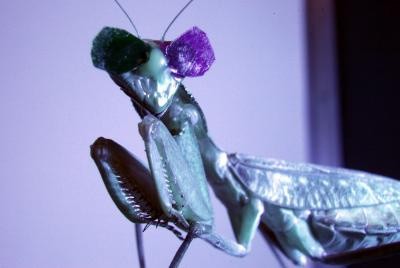The pet insect business and its consequences on biodiversity protection are the subjects of a new study.
Keeping insects as pets at home may sound unusual and geeky, but thousands of people worldwide have already done so.
Petting Praying Mantises

Praying mantises have recently gained appeal as pets and are being gathered in the wild by a rapidly developing group of enthusiasts and professional marketers.
An analysis of the industry's dynamics discusses both the issues and prospects of the pet mantis market, such as the lack of laws and the opportunity for greater biodiversity conservation collaboration between hobbyists and scientists.
These insects, sold at fairs and pet shops or captured in the wild and grown by amateurs or experts, are gaining appeal and driving a hitherto untapped industry.
They aren't all little, crawling beasts.
Some are graceful, with flower-like colors (such as the Orchid Mantis, Hymenopus coronatus), while others are cartoonish, like Pokémons (the Jeweled Flower Mantis, Creobroter wahlbergii).
Many can be securely managed and petted while looking at you with huge, lovely feline eyes (the Giant Shield Mantis Rhombodera basalis).
Things Customers Consider
Customers consider form, size, color, and temperament characteristics while choosing a pet bug.
They may also consider how uncommon a species is and how easy it is to care for.
The first review of the mantis pet market was published by Roberto Battiston of the Museo di Archeologia e Scienze Naturali G. Zannato (Italy), William di Pietro of the World Biodiversity Association (Italy), and entomologist Kris Anderson (USA) based on these preferences.
Understanding how this mostly unregulated market is evolving might be critical to rare species conservation and public awareness of their habitat and ecological role.
A study of almost 200 mantis amateurs, enthusiasts, and professional vendors from 28 nations revealed that the market's aims are predictable.
According to the report, the average mantis breeder or enthusiast is between 19 and 30 and buys mantises primarily for personal curiosity or scientific interest.
Most consumers willing to spend more than $30 on a single individual will choose attractive species over uncommon ones.
Buyers were identified as "primarily interested enthusiasts with insufficient awareness of the market dynamics and the rules underlying it," according to the study, which was published in the open-access Journal of Orthoptera Research.
The data also implies that the trade isn't always legal, as "approximately one out of every four times the buyer perceives the seller's lack of permissions or openness."
Conservation
According to the researchers, an excellent collaboration between science and this broad community might be critical for conserving mantises in the wild.
In biology, distribution, and dangers, mantises and insects, in general, are poorly understood, with many species still undiscovered and waiting to be discovered.
This places a significant constraint on their protection and conservation because you can't safeguard something you don't understand.
"A unique treasure for the scientific community is being produced and shared by hobbyists and pet bug aficionados on the biology and ecology of hundreds of species, including uncommon or still undescribed ones," the researchers concluded.
"Strengthening the interaction between them and encouraging a white market over a black market might be critical for the survival of these insects, which are essential aspects of our planet's biodiversity and are displacing our conventional pets at home."
For more news about the latest animal trends, don't forget to follow Nature World News
© 2025 NatureWorldNews.com All rights reserved. Do not reproduce without permission.





